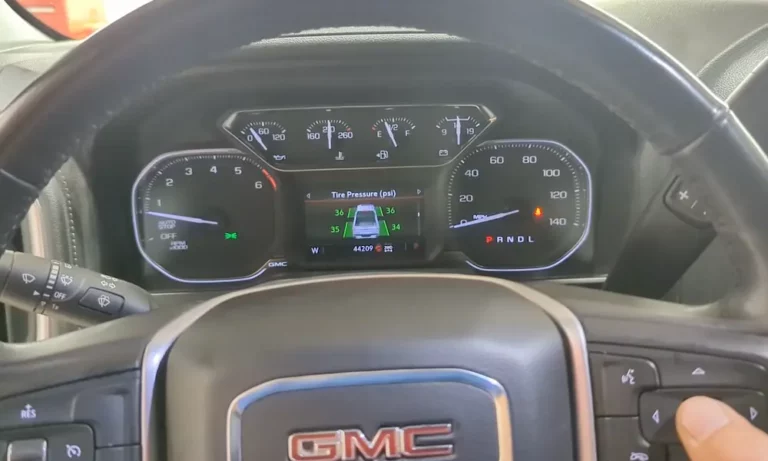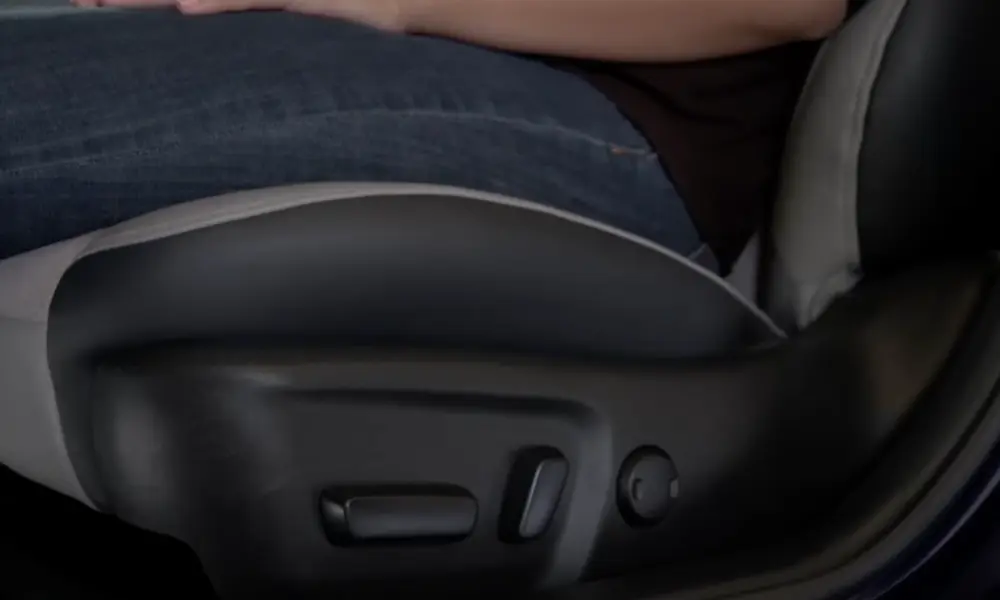Have you ever driven your GMC with that annoying tire pressure light glowing on your dash? Despite filling your tires properly, sometimes that stubborn warning just won’t go away. Don’t worry – you’re not dealing with a major mechanical issue. Most likely, you simply need to reset your GMC tire pressure sensor.
What is the GMC Tire Pressure Monitoring System?
The Tire Pressure Monitoring System (TPMS) in your GMC isn’t just another fancy feature – it’s a crucial safety system that continuously monitors the air pressure in your tires. These electronic sensors sit inside each tire, constantly measuring pressure levels and alerting you when they drop too low.
When your TPMS is working properly, it helps:
- Prevent dangerous blowouts
- Improve fuel efficiency
- Extend tire life
- Enhance vehicle handling
According to NHTSA, properly inflated tires can improve fuel efficiency by up to 3% and extend tire life by up to 25%.
Why Your GMC Tire Pressure Sensor Might Need Resetting
Your TPMS light might stay on for several reasons even after inflating your tires:
- The system hasn’t recognized the pressure change
- You’ve recently rotated or replaced tires
- Extreme temperature changes affected pressure readings
- A sensor battery is dying (they typically last 5-10 years)
- There’s an actual sensor malfunction
A properly functioning system protects both your vehicle and everyone in it. Let’s explore how to reset it.
Method 1: Using the TPMS Reset Button
The simplest reset approach works for many GMC models:
- Make sure all tires are inflated to the recommended PSI (check your driver’s door jamb sticker)
- Turn the key to “ON” position without starting the engine
- Find the TPMS reset button (typically under the steering wheel)
- Press and hold until the tire pressure light blinks three times
- Release the button and start the vehicle
- Let it run for about 20 minutes to complete the reset process
This manufacturer-recommended method is quick and doesn’t require any special tools or technical skills.
Method 2: The Driving Reset Approach
Sometimes, your GMC just needs a good drive to recalibrate:
- Ensure all tires match the recommended pressure
- Drive at speeds over 50 mph for 10-15 minutes on a highway
- The system may reset during this drive or after the next vehicle restart
This method works particularly well for minor pressure discrepancies or after routine maintenance. It utilizes the system’s built-in recalibration capabilities that activate during normal driving conditions.
Method 3: The Manual Pressure Adjustment Technique
For more stubborn reset issues, try this comprehensive approach:
- Over-inflate all tires by 3 PSI above the recommended pressure
- Completely deflate all tires (including the spare if equipped with a sensor)
- Reinflate each tire precisely to the manufacturer’s specifications
This method essentially gives your TPMS a clean slate by forcing it to recognize significant pressure changes. It’s particularly effective when other methods have failed.
Method 4: Battery Disconnect Reset
When simpler methods fail, try rebooting your vehicle’s electrical system:
- With the vehicle off, disconnect the positive battery cable using a wrench
- Turn the key to “ON” and press the horn for about three seconds (discharges remaining power)
- Reconnect the battery and start the vehicle
This approach clears temporary electrical glitches that might be affecting your TPMS functionality. Think of it as restarting your computer when a program freezes.
Advanced TPMS Sensor Relearning for GMC Vehicles
Standard Relearn Procedure
For situations involving new sensors or complex issues:
- Set the parking brake
- Turn ignition to ON/RUN (engine off)
- Press and hold the key fob’s LOCK and UNLOCK buttons simultaneously for 5 seconds
- Listen for two horn sounds confirming TPMS learn mode
- Starting with the left-front tire, use a TPMS tool against the tire sidewall near the valve
- Press the tool’s activate button and wait for a horn chirp
- Proceed to program remaining tires: right-front, right-rear, left-rear
- After the fourth sensor, the horn sounds twice to confirm completion
This procedure typically needs to be completed within 2 minutes for the first sensor and 5 minutes overall, or you’ll need to restart.
Model-Specific Procedures for Newer GMCs
The 2018-2024 Terrain and other newer models use a different approach:
- Turn ignition to accessory position
- Use steering wheel menu buttons to find the tire pressure display
- Press and hold the Checkmark button until “Tire Learning Active” appears
- Listen for two horn beeps
- Watch for indicator lights at each corner showing which tire to program first
- Use a TPMS tool in the order indicated (typically clockwise from driver’s front)
- The horn beeps twice when successfully completed
This visual guidance system makes the relearn process much more intuitive by clearly indicating which tire to program next.
TPMS Reset Tool Options
For advanced resets, you’ll need a specialized TPMS tool. Here are some options:
| Tool | Price Range | Features | Best For |
|---|---|---|---|
| ATEQ VT31 | $50-80 | Basic activation | DIY owners |
| VXDAS EL-50448 | $15-30 | GM-specific | Budget option |
| Autel TS508K | $200-300 | Programming, diagnostics | Professionals |
| Bartec Tech400Pro | $800+ | All makes/models | Repair shops |
Troubleshooting Persistent TPMS Issues
If your light stays on after reset attempts, investigate these common culprits:
Inaccurate Tire Pressure
Use a quality gauge to verify each tire matches the exact recommended PSI. Even small variances can trigger warnings.
Recalibration Delay
Some GMC models don’t reset immediately after pressure adjustments. Drive the vehicle for 15-20 minutes to allow the system time to recognize the correct pressure.
Sensor Battery Issues
A flashing (rather than solid) TPMS light often indicates a dying sensor battery. If your sensors are 5-10 years old, battery replacement may be necessary.
Damaged Sensors
Physical damage from impacts, improper tire installation, or previous repairs can damage sensors. Look for:
- Bent valve stems
- Corrosion around sensor components
- Visible damage to sensor housing
Extreme Temperature Fluctuations
A 10°F temperature drop can lower tire pressure by 1-2 PSI. If temperatures have changed dramatically, recheck and adjust tire pressures accordingly.
GMC Model-Specific TPMS Considerations
Different GMC models have slight variations in their TPMS operation and reset procedures:
Sierra/Silverado: Often use the button-reset method and may include spare tire monitoring in newer models.
Terrain/Equinox: Typically feature the visual guide system for sensor relearning.
Acadia: May require slightly longer driving periods for automatic resets.
Yukon/Tahoe: Often have more complex relearn procedures due to additional sensors.
Always consult your owner’s manual for model-specific instructions or visit the GMC owner center for detailed information.
Maintaining Your GMC TPMS System
To keep your TPMS functioning properly:
- Check tire pressure monthly using a quality gauge
- Always reset the system after tire rotation or replacement
- Have sensors inspected during regular service intervals
- Replace sensor batteries every 5-7 years (typically requires new sensors)
- Use TPMS-compatible tires and wheels for replacements
Remember that while the TPMS provides valuable warnings, it doesn’t replace regular tire maintenance. Make checking your tire pressure part of your regular vehicle care routine.
Preventing Future TPMS Issues
A few simple habits can prevent most TPMS problems:
- Maintain consistent tire pressure by checking monthly
- Address low pressure warnings promptly
- Inform tire service professionals about your TPMS before work begins
- Replace sensors preventively when batteries approach end-of-life
- Consider seasonal pressure adjustments for extreme temperature changes
According to tire industry studies, properly maintaining your TPMS system can extend sensor life by up to 30%.
The Bottom Line on GMC Tire Pressure Sensor Reset
Your GMC’s tire pressure monitoring system is a vital safety feature that helps prevent accidents, improves fuel efficiency, and extends tire life. While reset procedures vary by model and year, most GMC owners can successfully reset their TPMS using one of the methods outlined above.
Remember that the TPMS is designed to warn you of potentially dangerous conditions – if the light persists after reset attempts, don’t ignore it. Take the time to properly diagnose and address the issue to keep your GMC running safely and efficiently.
By understanding how to reset your GMC tire pressure sensor, you’re not just turning off an annoying light – you’re maintaining a crucial safety system that protects you and your passengers every time you drive.










